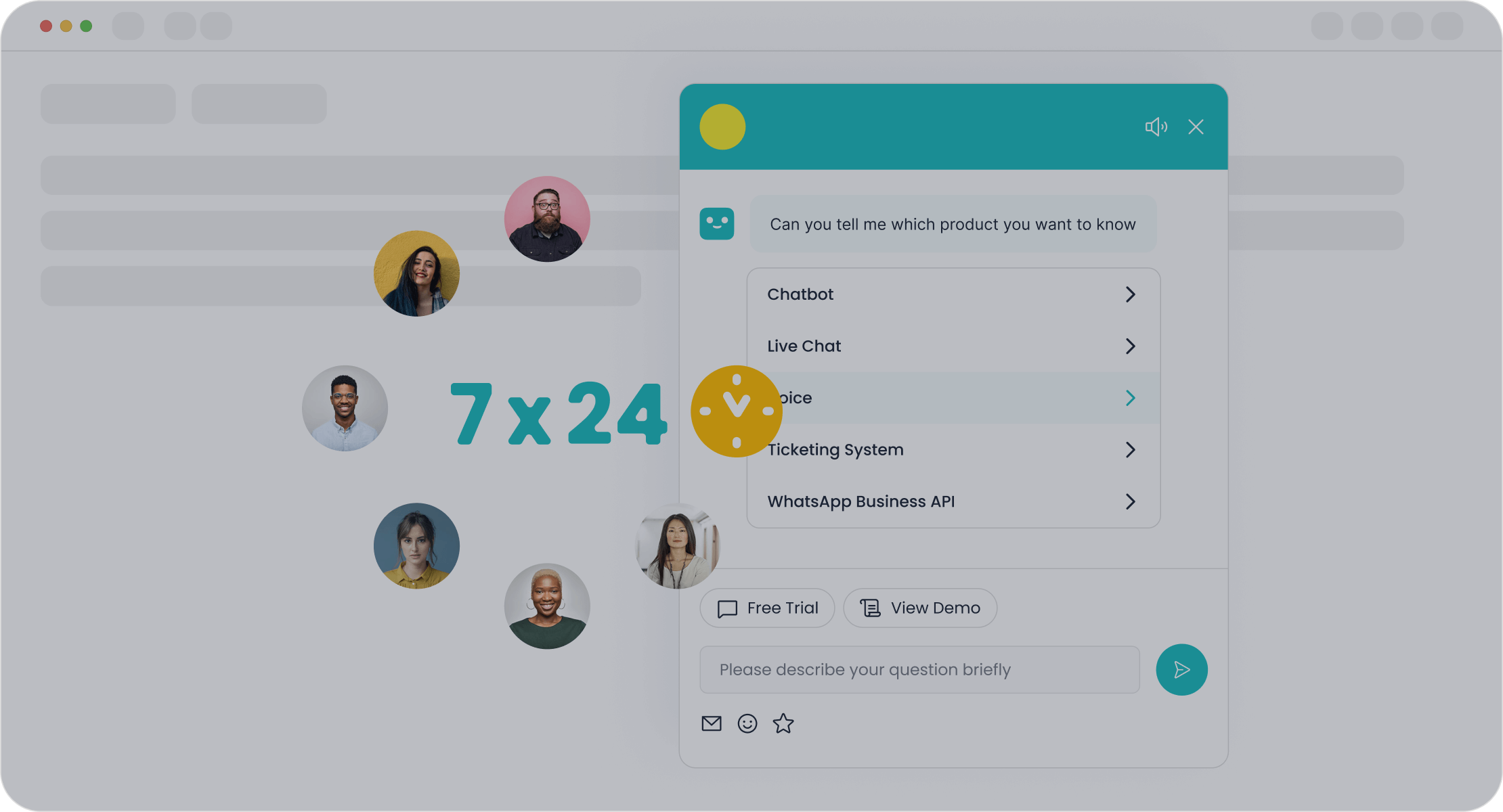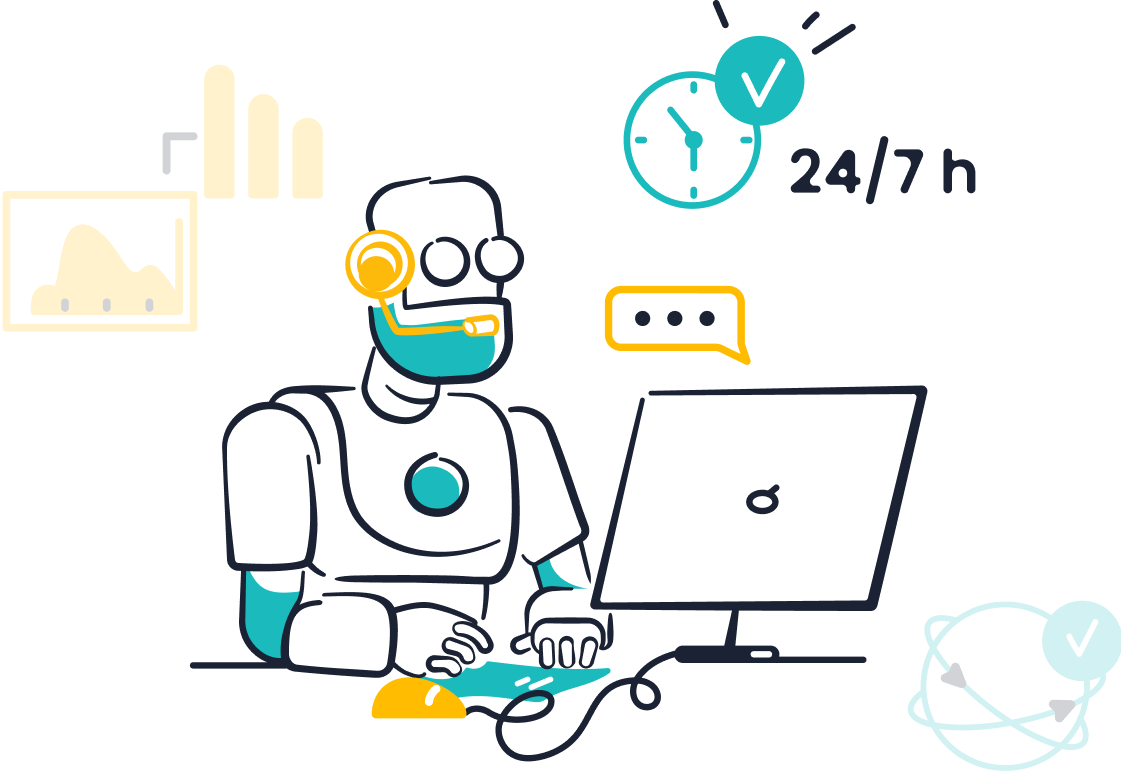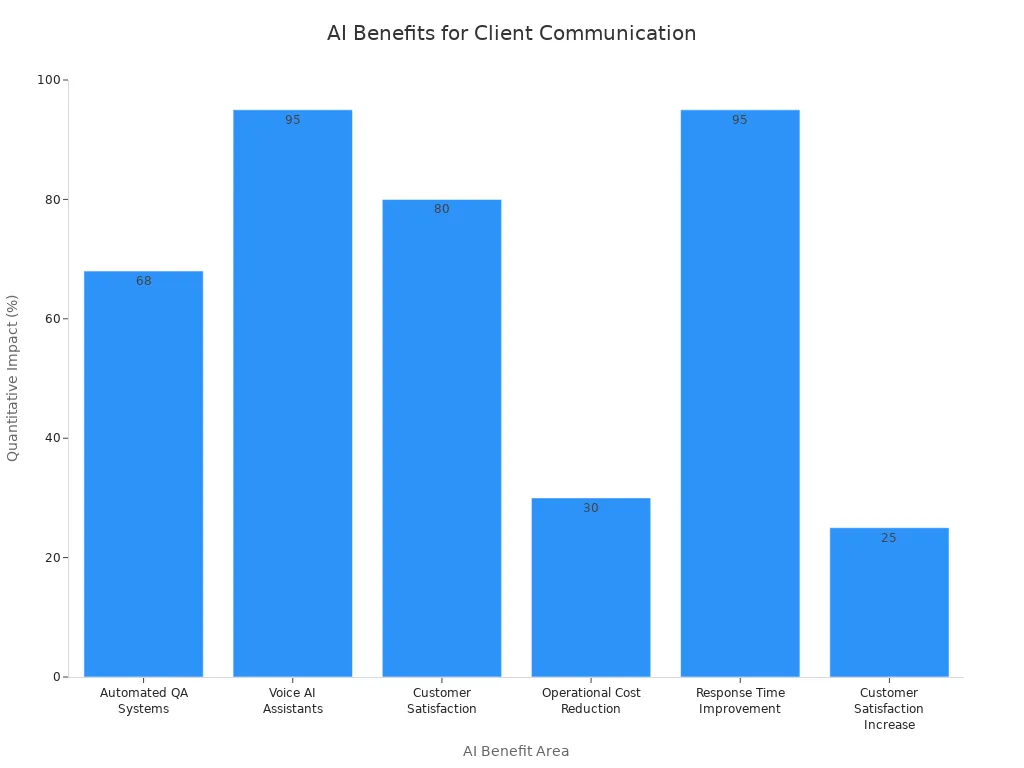How AI Is Transforming Client Communication Platforms

AI is transforming every client communication platform, making customer interactions faster, smarter, and more personalized. Businesses see that artificial intelligence can automate up to 70% of customer requests and resolve tickets 52% faster, which leads to higher customer satisfaction. Sobot AI helps companies streamline customer support with real-time analytics and proactive service. With solutions like Sobot call center, companies can handle more interactions across channels and boost efficiency. The rapid growth in AI adoption shows that companies must act now to stay ahead and improve customer interactions.
AI Trends in Client Communication
Evolution of AI Communication Platforms
Over the past decade, ai communication platforms have changed the way businesses interact with clients. Early platforms used simple, rule-based chatbots that relied on keywords and decision trees. These systems often struggled to understand user intent or maintain context. Today, ai team communication platforms use advanced technologies like natural language processing and machine learning. These improvements allow platforms to understand conversations, remember context, and generate human-like responses.
Businesses now deploy ai communication platforms across many channels, including chat, email, voice, and social media. This omnichannel approach ensures customers receive consistent support wherever they reach out. For example, a customer can start a conversation on WhatsApp and continue it on a website chat without repeating information. Companies in retail, healthcare, and education use these platforms to automate routine tasks, provide personalized recommendations, and streamline workflows.
The rise of conversational ai platforms such as Dialogflow and IBM Watson has made chatbot development accessible to businesses of all sizes. These platforms support 24/7 customer service, proactive engagement, and context-aware communication. In e-commerce, ai chatbots help customers track orders and receive product suggestions. In healthcare, they schedule appointments and offer mental health support. Education providers use ai team communication platforms for tutoring and administrative help.
Modern ai communication platforms integrate with business systems, allowing seamless data sharing and workflow automation. This integration improves customer satisfaction and operational efficiency. Businesses can now automate repetitive inquiries, deliver personalized experiences, and respond faster to client needs. The evolution of these platforms has set a new standard for client communication, making artificial intelligence a core part of customer engagement strategies.
Note: The shift from rule-based bots to intelligent ai team communication platforms marks a major milestone in the digital transformation of client communication.
Key 2025 AI Trends
The future of client communication platform development centers on several key ai trends. These trends shape how businesses connect with clients and drive operational success. The table below highlights the most significant ai trends influencing ai team communication platforms:
| AI Trend | Description | Business Impact |
|---|---|---|
| Conversational AI Operationalization | Smarter, emotionally-aware bots deployed across industries like retail, healthcare, finance. | Improved user engagement, personalized responses, 24/7 support, and competitive differentiation. |
| Model Training & Compute Growth | Training data grows 260% annually; compute power grows 360% annually over 15 years. | Lower per-interaction costs enabling smarter, more responsive bots. |
| Proactive Conversations | AI shifts from reactive to initiating conversations using real-time client data and intent recognition. | Enhanced engagement and personalized marketing experiences. |
| Cost Savings & Efficiency | Automation reduces repetitive tasks, agent workload, and average handle time. | Significant operational cost reductions and faster response times. |
| Market Growth | Conversational AI market expected to reach $32B by 2030 with 19% annual growth. | Strategic necessity for businesses to stay competitive. |
These trends show that ai communication platforms are not just tools for answering questions. They now drive proactive engagement, cost savings, and business growth. For example, ai-powered chatbots provide 24/7 support and automate routine tasks. This reduces costs and improves customer satisfaction. Chatbot interactions cost as little as $0.50 to $0.70 per session, compared to $19.50 per hour for human agents. Businesses see up to a 30% reduction in customer service expenses and a 67% increase in lead conversions.
The adoption of generative ai and multimodal ai is another important trend. These technologies allow ai team communication platforms to deliver personalized, context-rich support. By 2025, 85% of business leaders plan to adopt these solutions. Ai-powered voicebots enable natural, omnichannel voice interactions, bypassing traditional IVR systems and providing round-the-clock support. Ai-driven multilingual translation breaks language barriers, allowing businesses to serve global customers across chat, email, social media, and phone.
Tip: Companies that embrace these ai trends will gain a competitive edge by offering faster, more personalized, and more efficient client communication.
The growth of ai team communication platforms is rapid. General ai adoption in team communication platforms is expected to rise from 33% in 2023 to 71% in 2025 (McKinsey & Company). The ai in CRM market is projected to grow from $1.1 billion in 2020 to $6.7 billion by 2025. The generative ai market is forecasted to reach $356 billion by 2030, with a 46% annual growth rate. By 2025, 25% of enterprises will deploy ai agents, and 90% of companies using ai agents report improved workflows.
The following list summarizes the most impactful ai trends for the future of client communication platforms:
- Generative ai and multimodal ai for personalized, context-rich support.
- Ai-powered voicebots for natural, omnichannel voice interactions.
- Ai-driven multilingual translation for global communication.
- Agent augmentation and intelligent escalation management for better support quality.
- Proactive conversations using real-time client data and intent recognition.
- Automation of repetitive tasks to reduce agent workload and speed up response times.
Sobot stands at the forefront of these ai trends. The company integrates advanced ai technologies like natural language processing and large language models into its ai team communication platforms. Sobot’s ai agent delivers human-like communication, manages knowledge bases efficiently, and supports multiple languages. Enterprises using Sobot’s ai agent see a 15%-35% increase in direct response rates and up to a 90% reduction in knowledge base operation workload. Sobot’s platform supports chat, voice, email, and social media, ensuring seamless omnichannel support.
Sobot’s all-in-one ai-powered contact center platform reduces agent workload by 60%, increases conversion rates by 15%, and improves Net Promoter Score by 35%. The platform achieves resolution times under one minute through ai-human collaboration. Companies like OPPO and J&T Express have improved customer satisfaction and operational efficiency by adopting Sobot’s solutions. Sobot’s commitment to innovation and efficiency helps businesses stay ahead in the rapidly evolving landscape of ai communication platforms.
Looking to the future, ai team communication platforms will continue to evolve. Businesses will rely more on automation, proactive engagement, and personalized experiences. The integration of artificial intelligence into every client communication platform will become a strategic necessity. Companies that invest in these trends today will shape the future of customer engagement and set new standards for service excellence.
Sobot Chatbot in Client Communication Platforms

Chatbot Features and Benefits
Sobot Chatbot stands out as a leading solution in the world of ai team communication platforms. Businesses choose Sobot for its advanced features, measurable efficiency gains, and significant cost savings. The platform uses ai to automate routine customer interactions, freeing human agents to focus on complex issues. This approach leads to faster response times and improved customer satisfaction.

Sobot Chatbot offers a range of unique features that set it apart from traditional chatbots:
- Integrates ai-powered sentiment analysis, which goes beyond simple keyword detection. The chatbot analyzes tone and context to interpret customer emotions during every interaction.
- Provides real-time sentiment insights through a live dashboard. Businesses can monitor customer mood and quickly respond to changes, which helps increase satisfaction and revenue.
- Supports multilingual sentiment analysis. Sobot accurately understands customer sentiment in different languages, which is essential for global brands.
- Delivers proven results. For example, Agilent saw a sixfold increase in customer service efficiency by using Sobot to handle routine queries, allowing agents to focus on more complex tasks.
- OPPO achieved an 83% chatbot resolution rate and a 94% positive feedback score after deploying Sobot for repetitive queries.
- Combines sentiment analysis, automation, and integration capabilities. Sobot goes beyond answering questions by tracking emotional context and providing real-time feedback.
The platform’s impact on efficiency and cost savings is clear. Sobot Chatbot automates up to 70% of customer queries, which boosts productivity and reduces the need for additional staff. Companies report significant improvements in key metrics after implementing Sobot. The table below highlights some of these results:
| Company | Efficiency Gains / Metrics | Cost Savings / Improvements |
|---|---|---|
| OPPO | 83% chatbot resolution rate; 57% increase in repurchase rate | N/A |
| Samsung | 97% customer satisfaction rate | N/A |
| Agilent Technologies | 6x increase in service efficiency; 95% customer satisfaction | 25% reduction in service costs |
| Opay | Customer satisfaction improved from 60% to 90% | 20% cost reduction |
| General Sobot Impact | Automated resolution rates boosted by 15-35%; up to 70% productivity improvement | Up to 50% reduction in service costs |
Sobot Chatbot drives collaboration between ai and human agents. The chatbot handles repetitive questions, while agents focus on more complex requests. This team collaboration model increases productivity and ensures customers receive fast, accurate answers. Businesses also benefit from improved First-Contact Resolution (FCR), which reduces repeat contacts and lowers operational costs. McKinsey estimates that ai-powered chatbots like Sobot can reduce service costs by up to 35% on average (source). Companies avoid expenses related to hiring, training, and overtime, and can scale support during busy periods without extra costs.
Sobot’s platform supports team collaboration by providing real-time insights and analytics. Managers can track performance, monitor sentiment, and identify areas for improvement. The chatbot’s customizable interface allows businesses to tailor workflows to their needs, making it suitable for organizations of all sizes. Sobot’s ai-driven approach to team collaboration ensures that every customer receives enhanced customer service, no matter the channel or language.
Note: Sobot Chatbot’s combination of advanced ai features, measurable efficiency gains, and cost savings makes it a top choice for businesses seeking to modernize their client communication platforms.
Omnichannel and Multilingual Support
Modern businesses need to engage customers across many digital platforms. Sobot Chatbot delivers true omnichannel support, allowing seamless communication through chat, voice, email, social media, and messaging apps. This flexibility ensures customers can reach out on their preferred channel and receive consistent, high-quality support.
Sobot’s omnichannel capabilities include:
- Integration of chatbot functionality, live chat, voice support, ticketing systems, and messaging, including the WhatsApp Business API.
- Unified live chat workspace, where agents manage all conversations from different channels in one place.
- AI-powered voicebots for inbound and outbound calls, using global numbers to reach customers worldwide.
- Collaborative ticketing systems that streamline issue resolution and support team collaboration.
- Real-time ai copilots for agents, smart FAQ, zero-wait handoff, and customizable user interfaces.
- Integration with existing business systems, secure data transfer, and comprehensive analytics for performance tracking.
Sobot supports team collaboration by enabling agents and ai to work together across all channels. The platform’s design allows for fast, adaptive, and human-like interactions, which improves customer experience and builds trust. Businesses can scale their support operations easily, serving both small and large customer bases without sacrificing quality.
Multilingual support is another key strength of Sobot Chatbot. The platform supports over 18 languages, making it ideal for global businesses. Multilingual ai chatbots allow companies to communicate with customers in their preferred language, without hiring multilingual staff. This approach reduces operational costs and speeds up international expansion. Businesses report up to 40% faster entry into new markets when using multilingual chatbots that provide immediate local-language support.
Key benefits of multilingual support include:
- Breaking language barriers, which allows companies to serve customers in new regions.
- Replacing multiple language-specific support channels with a single, unified solution.
- Providing 24/7 support in local languages, which improves customer satisfaction and trust.
- Maintaining consistent brand messaging across all languages by using a single knowledge base.
- Supporting industries like healthcare and financial services with localized, reliable support for tasks such as appointment scheduling and transaction assistance.
Sobot’s multilingual capabilities enhance team collaboration by allowing agents and ai to work together on global support tasks. The platform’s secure, scalable design ensures that businesses can maintain high service standards as they grow. Sobot’s focus on collaboration, ai-driven automation, and multilingual support positions it as a leader in enhanced customer service for companies worldwide.
Tip: Companies that invest in omnichannel and multilingual ai-powered chatbots like Sobot can expand faster, reduce costs, and deliver a seamless customer experience across every touchpoint.
Personalization and Customer Experience
AI-Driven Personalization
AI-driven personalization has become a cornerstone of modern customer experiences. Businesses now use advanced AI to analyze customer data from every interaction, including browsing, purchases, and feedback. This approach allows companies to predict preferences and deliver highly personalized customer interactions. The following table highlights how different AI personalization features impact customer experience:
| AI Personalization Feature | Description and Impact on Customer Experience |
|---|---|
| AI-powered Chatbots | Offer personalized, conversational support 24/7, understanding queries and providing tailored responses for higher satisfaction. |
| Content Personalization | Delivers emails, articles, and product suggestions based on user interests, increasing engagement and saving resources. |
| Predictive Personalization | Anticipates customer needs using historical data, making experiences more relevant and convenient. |
| Hyper-personalization | Uses real-time data for dynamic website content and marketing, boosting engagement and relevance. |
| Omnichannel Personalization | Ensures consistent, personalized experiences across all channels, creating a seamless journey. |
| Generative AI | Produces marketing content tailored to individual preferences, improving content relevance and efficiency. |
AI chatbots, like those from Sobot, analyze customer behavior to create personalized messages and recommendations. This customer-centric personalization builds trust and loyalty, making users feel understood. Companies such as Netflix and Starbucks have seen up to a 25% increase in sales and a 75% reduction in churn by leveraging AI-powered personalization. Personalized customer interactions also drive higher engagement, with tailored offers and content increasing the likelihood of purchase and repeat visits.
Companies using AI personalization report a 25% increase in customer satisfaction and a 20% reduction in churn rate, according to Forrester.
Sentiment and Speech Analytics
Sentiment and speech analytics play a vital role in enhancing customer experiences. AI analyzes every customer interaction, capturing emotional cues and tonal shifts that traditional surveys often miss. This technology provides real-time, context-rich insights, allowing businesses to tailor responses and resolve issues quickly.
- Speech analytics reviews 100% of customer interactions, offering a complete view of customer sentiment.
- Real-time dashboards help reduce negative sentiment by 34% and improve customer satisfaction scores.
- Sentiment models score expressions from negative to positive, capturing nuances like frustration or satisfaction.
- AI-generated conversation summaries reduce administrative work, letting agents focus on meaningful customer interactions.
- Integration with CRM tools ensures seamless management of customer experiences across all channels.
Sobot’s AI-powered platform uses these analytics to monitor interactions, identify trends, and provide actionable feedback. Companies report an average ROI of 287% over three years after integrating sentiment analysis. Microsoft and Adobe improved user satisfaction by over 20% through sentiment-driven development. By understanding customer emotions and adapting communication strategies, businesses can deliver more personalized and effective customer experiences.
Tip: Real-time sentiment and speech analytics help businesses anticipate customer needs, resolve problems faster, and build stronger relationships.
Contact Center Automation with AI

Automated Workflows
Contact center automation has changed how teams manage customer service. Companies now use automation tools to handle routine tasks and improve response times. These tools include robotic process automation for data entry, chatbots for simple questions, and intelligent call routing. Automated systems direct customers to the right agent, reducing wait times and improving satisfaction.
Many contact centers rely on automation in contact centers to streamline operations. Common automated workflows include:
- Robotic process automation for tasks like ticket creation and data entry
- AI-powered chatbots and virtual assistants for 24/7 self-service
- Interactive voice response systems with speech recognition for voice navigation
- Workflow automation for routing tasks and escalating issues
- Omnichannel routing to keep customer experiences consistent across channels
- Predictive analytics for staffing and call volume forecasting
These automation tools help teams eliminate bottlenecks and reduce manual errors. Sobot’s platform, for example, uses AI-driven automation to manage omnichannel support, automate ticketing, and provide instant self-service. This approach leads to faster resolutions and lower costs. Companies see improved operational efficiency and better customer experiences when they use contact center automation.
Tip: Automated workflows free agents to focus on complex issues, making team collaboration more effective.
Agent Assistance and Augmentation
AI-powered automation tools now support agents in real time. These tools provide instant access to knowledge bases, suggest next steps, and analyze customer sentiment. Generative AI can create post-call summaries and recommend follow-ups, saving agents time. Multimodal support lets agents handle chat, email, voice, and social media with full context.
Key automation tools for agent assistance include:
- Real-time guidance and recommendations during calls
- Automated call summaries and conversation scoring
- Sentiment analysis and predictive analytics for better responses
- Integration with CRM systems for personalized service
- Automated coaching and quality analysis for continuous improvement
AI-driven automation in contact centers improves agent performance. Studies show agents handle 13.8% more inquiries per hour with AI assistance. Real-time feedback boosts first contact resolution by 12% and customer satisfaction by 15% (Forrester). Sobot’s solutions offer these features, helping teams achieve higher productivity and better collaboration. As the future of contact centers evolves, automation tools will play a bigger role in team collaboration and service quality.
Note: Automation in contact centers drives measurable gains in agent productivity, customer satisfaction, and team collaboration.
Implementing AI Communication Platforms
Integration Steps
Organizations must follow a structured approach to integrate ai communication platforms into their business systems. Successful integration starts with leadership support. The C-suite must champion the adoption of ai and automation. Teams should build an ai-friendly culture by addressing concerns and encouraging interaction with new automation tools.
A step-by-step process helps ensure smooth implementation:
- Assess business needs and identify processes that benefit most from automation.
- Secure buy-in from leadership to drive adoption and resource allocation.
- Prepare the communication infrastructure for ai requirements, such as high-speed networks and reliable uptime.
- Invest in data management to maintain clean, unified data for accurate ai outputs.
- Select ai communication platforms compatible with existing systems.
- Define clear use cases that align with business goals and prioritize high-impact areas.
- Train employees and ai systems to optimize performance and foster team collaboration.
- Pilot ai solutions in controlled environments before full deployment.
- Integrate and test ai tools within current workflows, ensuring seamless collaboration between automation tools and human agents.
- Monitor performance, optimize solutions, and scale based on results.
Legacy system integration often presents challenges. Outdated technology, incompatible data formats, and limited processing power can slow progress. Teams may need to modernize APIs or update data architecture. Phased integration and unified platforms help reduce complexity and cost. Sobot’s platform, for example, offers seamless integration with existing business systems, supporting omnichannel communication and team collaboration across departments.
Tip: Early investment in training and change management increases user adoption and builds trust in automation.
Security and Compliance
Security and compliance remain top priorities when deploying ai communication platforms. Organizations must protect sensitive data and meet regulatory requirements. Best practices include:
- Implementing robust security protocols, such as encryption, access controls, and continuous monitoring with anomaly detection.
- Using data protection techniques like anonymization and pseudonymization to safeguard information during ai training.
- Conducting regular security audits and penetration testing to identify vulnerabilities.
- Maintaining incident response plans for quick action during security breaches.
- Providing ongoing employee training on ai-specific security risks and safe use of automation tools.
- Ensuring compliance with regulations such as GDPR, CCPA, HIPAA, and the EU AI Act, depending on industry and region.
A table summarizes key regulations by industry and region:
| Industry/Region | Key Regulations & Laws | Compliance Focus Areas |
|---|---|---|
| United States | CCPA, FTC, FCRA, BIPA | Data privacy, transparency, consent |
| European Union | GDPR, EU AI Act | Data protection, auditability, risk management |
| Financial Services | AML, KYC, fair lending | Transparency, human oversight, explainability |
| Healthcare | HIPAA, FDA regulations | Patient data protection, audit trails |
| Insurance | Fairness audits, explainable AI | Bias testing, transparency |
Sobot’s solutions support compliance through secure data handling, role-based access controls, and regular updates. The platform enables organizations to maintain transparency and accountability while leveraging automation and team collaboration. By following these best practices, businesses can build trust with customers and regulators, ensuring long-term success with ai communication platforms.
Note: Regular risk assessments and collaboration with regulatory bodies help organizations stay ahead of evolving compliance requirements.
Sobot Success Stories
OPPO Case Study
OPPO, a global leader in smart devices, transformed its client communication by partnering with Sobot. The company faced challenges during high-demand periods, such as shopping festivals, when customer inquiries surged. Sobot’s ai-powered chatbot and ticketing system provided a solution that combined automation with human expertise. This collaboration allowed OPPO to manage large volumes of requests efficiently.
- OPPO improved customer service efficiency and satisfaction through automation of basic inquiries.
- Operational costs dropped as the chatbot handled routine questions, freeing agents for complex issues.
- The omnichannel platform centralized all customer interactions, making communication seamless.
- Data-driven ai solutions enabled personalized responses, which increased customer loyalty.
- Enhanced feedback and data management led to better decision-making and faster problem resolution.
After integrating Sobot, OPPO achieved an 83% chatbot resolution rate and a 94% positive feedback score. Customer satisfaction scores rose by over 30%, Net Promoter Score increased by more than 35%, and conversion rates improved by over 15%. These results show how effective collaboration between ai and human agents can drive measurable business outcomes.
Industry Impact
Sobot’s impact extends across many industries. Companies in financial services, healthcare, influencer marketing, IT, industrial equipment, and food & beverages have adopted Sobot’s solutions. The platform integrates ai-powered chatbots with WhatsApp Business API, enabling faster response times and improved satisfaction. Teams benefit from collaboration tools that automate routine inquiries and provide real-time tracking.
- Users report a 35% productivity boost and fewer errors due to automated payment tracking and reporting.
- Off-hour chatbot automation supports customer queries, enhancing engagement and retention.
- WhatsApp integration has become a preferred channel for client inquiries, improving communication efficiency.
- In the industrial equipment sector, process mining and automation reduced manufacturing delays and improved satisfaction.
Sobot’s user-friendly interface and multi-channel integration support collaboration at every level. Teams can focus on complex tasks while ai handles repetitive work. This approach has transformed client communication, making collaboration central to success in modern businesses.
AI continues to reshape client communication platforms, driving efficiency, collaboration, and customer satisfaction. Sobot’s AI solutions deliver omnichannel consistency, real-time analysis, and proactive engagement, resulting in faster, more personalized customer experiences. Companies achieve up to a 95% reduction in response times and a 25% increase in customer satisfaction.

To prepare for the future, organizations should evaluate their current platforms, explore Sobot’s no-code automation, and leverage full-cycle support for seamless collaboration and improved customer interactions.
FAQ
What is a client communication platform?
A client communication platform is a digital system that helps businesses manage conversations with customers across channels like chat, email, voice, and social media. Sobot’s platform supports omnichannel communication, enabling seamless interactions and improving customer satisfaction.
How does AI improve client communication platforms?
AI communication platforms automate routine tasks, analyze customer sentiment, and provide real-time support. For example, Sobot’s AI team communication platforms resolve up to 70% of queries automatically, reducing response times and boosting efficiency. AI also enables personalized experiences for every customer.
Can Sobot’s AI chatbot handle multiple languages?
Yes. Sobot’s AI chatbot supports over 18 languages, making it ideal for global businesses. Multilingual support allows companies to serve customers worldwide without hiring extra staff. This feature helps break language barriers and speeds up international expansion.
What are the main benefits of using AI team communication platforms?
AI team communication platforms like Sobot offer faster response times, lower operational costs, and improved customer satisfaction. Companies report up to a 50% reduction in service costs and a 35% increase in productivity after implementing AI-powered solutions.
How secure are AI-powered client communication platforms?
Sobot’s client communication platform uses encryption, role-based access controls, and regular security audits. The platform complies with regulations such as GDPR and CCPA. These measures protect sensitive data and ensure safe, reliable customer interactions.
Tip: For more details on Sobot’s AI solutions, visit Sobot’s official website.
See Also
How AI Agents Are Transforming Customer Support Services
An In-Depth Look At AI Solutions For Call Centers
Best AI Tools To Enhance Enterprise Contact Centers
